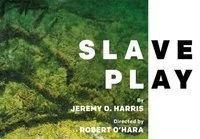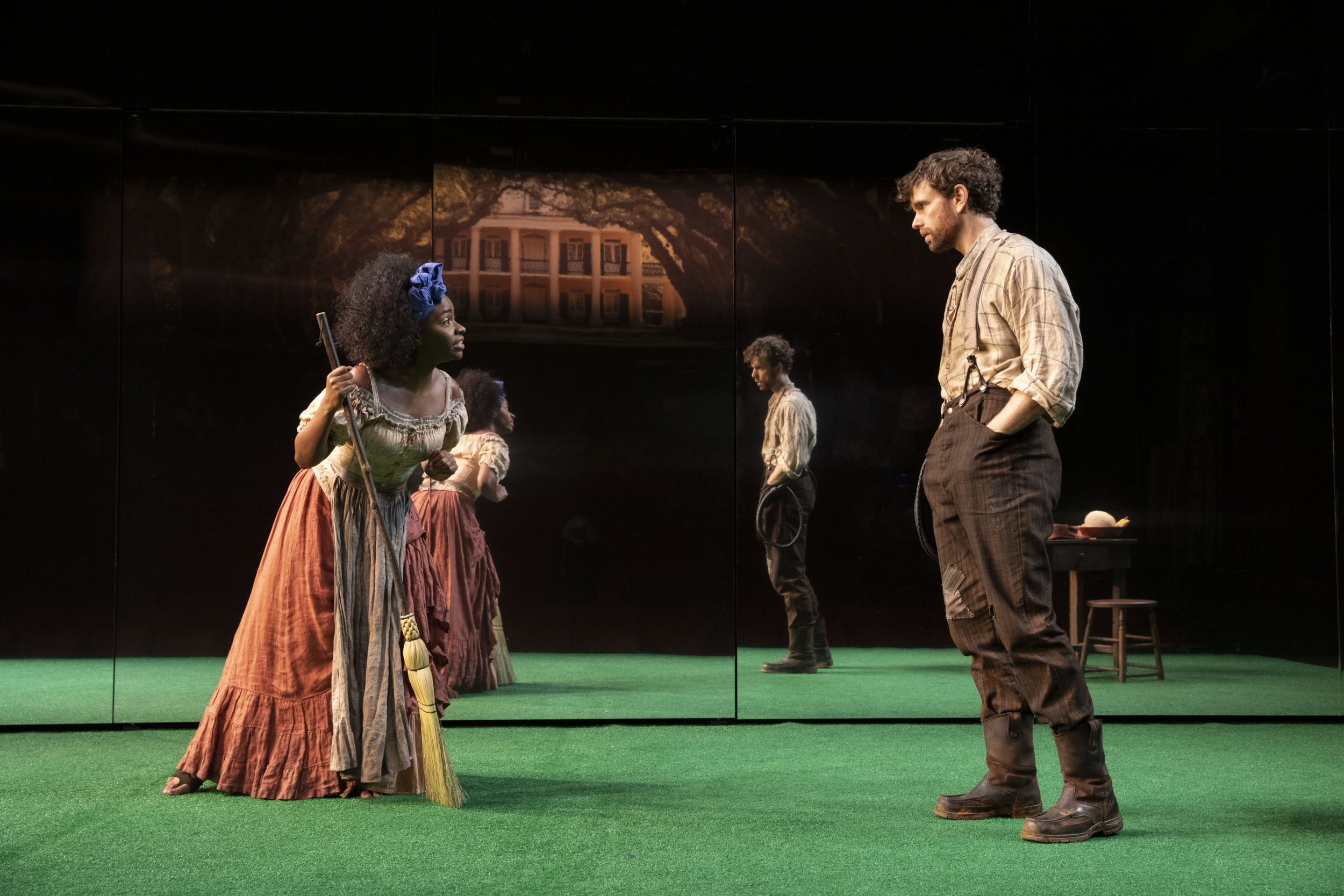REVIEW: “Slave Play”
Teyonah Parris and Paul Alexander Nolan in the opening moments of “Slave Play”. Photo Credit: Joan Marcus
You can tell something’s not quite right from the opening moments of Jeremy O. Harris’s “Slave Play” at New York Theatre Workshop.
From a door in the towering mirror walled set by Clint Ramos, Kaneisha (Teyonah Parris), a black slave, emerges with a broom and commences to very poorly and awkwardly attempt to sweep her surroundings before Rihanna’s “Work” chimes in and she’s overcome by her uncontrollable impulse to start twerking.
Instantly, we, the audience, are submerged into a fantastical state of anachronistic confusion that will last for at least the first third of the play. Reflected in that mirror wall is a giant painting of the McGregor Plantation suspended behind the audience. We’re looking forward, but cannot escape the past, and that is the central metaphor at work. Any time you enter a theatre and see a mirror facing the audience, you know some introspection, if not indictment, is sure to follow.
Kaneisha is soon joined by the overalls and straw hat clad Mister Jim (Paul Alexander Nolan), her overseer who sees himself as having no greater station in life than hers but for the fact that he’s her “manager”. The power dynamic of their relationship unfolds, nevertheless, as forces her to get on the floor, whip cracking, and eat the shards of an exploded cantaloupe he cast to the ground. Each visibly aroused, the scene ends with an eruption of forbidden sexual congress between the two.
Paul Alexander Nolan and Teyonah Parris. Photo Credit: Joan Marcus.
The play proceeds to introduce two other interracial couples in vignettes featuring similar sexual displays of dominance and subservience: Alana (Annie McNamara), the lady of the plantation, and Philip (Sullivan Jones), a mulatto house slave she summons to her boudoir to play his fiddle, and Dustin (James Cusati-Moyer), a white indentured servant, and Gary (Ato Blankson-Wood), a slave deputized as his overseer in the fields. Both scenes crescendo in explicit and memorable ways, before Kaneisha and Jim return, and the play itself takes a turn, cashing in on our suspicion that something else is afoot on the McGregor Plantation.
Sullivan Jones and Annie McNamara. Photo Credit: Joan Marcus.
It is impossible to talk about “Slave Play” any further without giving away its central, genuinely surprising twist; then again, it is nearly impossible to score a ticket to its sold-out engagement, so read on if you are interested. The play is not, as its title might suggest, about literal slaves. Instead, “slave play” refers to an imagined form of interracial sexual fantasy role-play termed “Antebellum Sexual Performance Therapy”, a practicum cut short when Jim calls the safe word: “Starbucks”.
Ato Blankson-Wood and James Cusati-Moyer. Photo Credit: Joan Marcus.
Our three couples are participants in an experimental retreat hosted by Teá (Chalia La Tour) and Patricia (Irene Sofia Luco), themselves an interracial couple, designed to “help black partners re-engage intimately with white partners from whom they no longer receive sexual pleasure”.
The theory is for these partners to regress to antebellum racial dynamics as a way to work out inherited trauma and bias, address their anhedonia (inability to feel pleasure), “radically center the black body in discourses around white supremacy”, and move forward—a sort of interpersonal racial reconciliation that American society writ large has never been too good at.
The second third of the play consists of a semi-absurdist group therapy session, post “slave play”, that at once satirizes contemporary conventions of racial discourse about privilege and identity (the words “hear”, “space”, and “process” drop with hilarious pace) while vividly demonstrating their very operation among the characters.
Alana, a white woman, can’t stop talking. Philip, who is a light skinned person of color, sees himself as post-racial and unable to access his own racial trauma. Kaneisha, a black woman, is paralyzed by alexithymia, “the inability to describe your own feelings”. Jim, a white man, dismisses himself and leaves the room, while Gary, who is black, and Dustin, who is “not white” but clearly passes for white, spar over the complexity of that dynamic.
Each character is a “type”, yet none feels trapped in a box. Mr. Harris’s provocative construct, under the direction of two-time Obie Award winner Robert O’Hara (Bootycandy), provides a scintillating and unique way to dramatize and explore urgent and fascinating questions of race, gender, and sexuality in contemporary America, threading a fine needle that allows its characters their humanity while also standing in for larger arguments.
The looming plantation is a constant reminder of the inescapability of the past, and our collective challenge in confronting it in a productive way in the present that gives voice to the experiences of people of color and produces a better future. The language and sexually explicit conduct might make some theatregoers squirm, but the substance could not be more relevant and important for theatregoers to ponder.
“Slave Play”, at turns uproariously funny and graphically scary, is not an easy play to dissect and process (a favorite word of Teá and Patricia’s), but it is impossible not to emerge from the theatre, head-spinning, primed to do just that. And this, to me, is an unqualified good, for at least in white America, it is too easy to look in the mirror and not see the plantation that is always there.
Despite still being a playwriting student at the Yale School of Drama, Mr. Harris has managed to create a work of great magnitude; be sure to put him, and “Slave Play”, on your radar.
Bottom Line: Jeremy O. Harris’s scintillating debut play, “Slave Play” at New York Theatre Workshop, is not what you think it is, packing twists, some heavy satire, graphic sexuality, and an important discourse on race, gender, and sexuality in contemporary America. To write about it is to spoil its surprises, but this sold out run will no doubt inspire future productions.
_______________
“Slave Play”
New York Theatre Workshop
79 East Fourth Street
New York, NY 10003
Running Time: two hours (no intermission)
Opening Night: November 19, 2018
Final Performance: January 13, 2019
Sold Out





